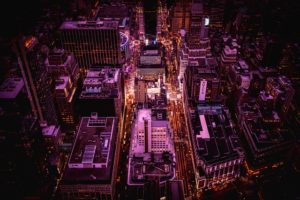 LEDs have stepped out of [city] homes and into public spaces like parks, stadiums, and streets. Given their energy efficiency and long lifespan, it’s no surprise why LEDs are perfect for outdoor and street lighting. As more and more cities change their infrastructure lights to LEDs, these lights, characterized by their bright white glow, are quickly becoming synonymous with improved public safety and lighting quality.
LEDs have stepped out of [city] homes and into public spaces like parks, stadiums, and streets. Given their energy efficiency and long lifespan, it’s no surprise why LEDs are perfect for outdoor and street lighting. As more and more cities change their infrastructure lights to LEDs, these lights, characterized by their bright white glow, are quickly becoming synonymous with improved public safety and lighting quality.
In this post, we look at 6 examples of American cities powered by LED lighting.
Detroit
Detroit currently has one of the largest LED street light projects in the country. From once being powered by old high-pressure sodium lights, Detroit finally made a major lighting upgrade after several decades poor lighting. In fact, the Public Lighting Authority of Detroit estimates that 40 percent of their old street lights were not operational due to burned out light bulbs, damaged infrastructure, or theft of the copper in the wiring.
Detroit’s LED upgrade was completed in 2016, with the city having successfully installed 65,000 LED street lights, generating an annual savings of $2.4 million.
Los Angeles
Photos of Los Angeles’s skyline went viral after the city’s switch to LED street lights. The city’s once orange skyline, caused by high-pressure sodium lamps, transformed into a bluish-white glow after its LED retrofit. A project involving the replacement of over 140,000 street lights, Los Angeles completed the effort in 2013, capping off a 4-year campaign to upgrade to LEDs.
The city now pays just $7.5 million annually for its lighting, a major drop from the $16 million it used to pay for street lighting.
Boston
As of 2015, Boston has invested $6.8 million dollars in its LED street light project. So far, the city has successfully upgraded 42,000 mercury vapor lamps and over 22,000 high-pressure sodium street lights to white LEDs, giving their streets a brighter look. The city estimates that by the time the project is completed in 2018, Boston would save over $2.8 million a year in electricity costs.
Portland
In 2014, the City of Portland initiated a two-year project to convert 55,000 street lights to LEDs. By the first year of the program, the city had successfully reached a little under half of their target number and was already saving $100,000 per month on electricity expenses. The Portland Bureau of Transportation, which oversees the city’s street light upgrade, expects a drop of about 20 million kilowatt hours every year after the project has been fully implemented.
New York City
In the city that never sleeps, city officials are planning to convert all 250,000 of their sodium vapor street lights to LEDs. The project, announced in October 2013, is expected to wrap up in 2017.
As the New York Times notes, the project’s goal is to minimize the city’s carbon emissions by 30% and save up to $6 million and $8 million on electricity costs and street light maintenance, respectively. Even the lights at the top of the iconic Empire State Building are now powered by LEDs, which put up a light show on special occasions.
San Francisco
In 2012, San Francisco sought to replace 18,500 high-pressure sodium lights with LEDs. Estimating the project to be completed in 2017, the city hopes to cut electricity consumption by over 50 percent and reduce maintenance costs, maybe even go maintenance-free, for the next 15 to 20 years.
With LEDs unmatched when it comes to energy efficiency and durability, it’s no wonder more and more cities are using them to upgrade their street lighting. Bottom line? LED street lights help cities save millions of dollars a year in electricity and maintenance costs, all while keeping the general public safe with better light quality.

![5 Bright Ideas for Healthier Workplace Lighting in [city] [city]](https://eepros.com/wp-content/uploads/2020/03/man-162951_640-300x212.jpg)
![Meet Igor And Reduce Your Lighting Bills [city]](https://8blocks.s3.amazonaws.com/eepros/blog-images/2014/11/Igor-300x170.png)
![HELIUS ILLUMINATION JOINS ENERGY EFFICIENCY PROS BUYING ALLIANCE [city]](https://8blocks.s3.amazonaws.com/eepros/blog-images/2014/06/helius-commercial-300x199.jpg)
![The 5 Baseline Requirements of Great Office Lighting [city]](https://eepros.com/wp-content/uploads/2018/02/led-bulb-1-300x169.jpeg)